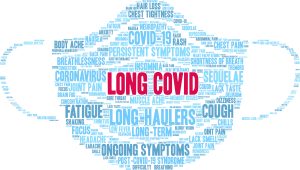 Nearly three years after contracting a mild case of COVID-19, Cynthia Adinig still has problems with her throat. It often feels tight, she has trouble swallowing, and her voice is hoarse. The 37-year-old must meter her energy. She’s been hospitalized for malnutrition and dehydration because she couldn’t eat or drink enough to meet her body’s demands. The last two-and-a-half years of her life, Adinig said, have been “miserable.”
Nearly three years after contracting a mild case of COVID-19, Cynthia Adinig still has problems with her throat. It often feels tight, she has trouble swallowing, and her voice is hoarse. The 37-year-old must meter her energy. She’s been hospitalized for malnutrition and dehydration because she couldn’t eat or drink enough to meet her body’s demands. The last two-and-a-half years of her life, Adinig said, have been “miserable.”
Explore This Issue
May 2023Jackie Dishner is another of the 30 million or so Americans who are experiencing post-acute sequelae of SARS-CoV-2 infection, also called long COVID. The Arizona resident lost her sense of smell in June 2020 when she contracted COVID-19, and it’s still not back to normal. Her bowel movements smell like green pepper, she says. Tastes and smells are “muffled” and inconsistent. She tried olfactory training at home using an essential oils kit she purchased online but didn’t notice a significant improvement.
“Somehow, the virus changed how my brain speaks to my mouth and nose,” Dishner said. “I don’t think my sense of taste and smell will ever return to what they were before.”
Dishner is a writer and artist, not a physician or scientist. But her interpretation of her experience lines up with the latest scientific thinking. Long COVID otolaryngologic symptoms “largely seem to be related to some sort of neurological change,” said Diana Kirke, MBBS, MPhil, assistant professor in the department of otolaryngology–head and neck surgery at the Icahn School of Medicine at Mount Sinai in New York City.
Researchers also know that SARSCoV-2, the virus that causes COVID-19, attaches to epithelial cells surrounding olfactory neural cells, and rodent studies have shown that although damaged nasal epithelium can recover and create new neurons, the axons that find their way back to the olfactory bulb don’t target the same area as the original neurons. That disruption may explain why some people experience parosmia and anosmia after COVID-19 infection.
According to the American Academy of Physical Medicine and Rehabilitation and articles in the Journal of the American Medical Association and Nature Reviews Microbiology, at least 10% of individuals who had COVID-19 reported at least one persistent symptom up to six months after initial infection, with approximately 15% continuing to experience symptoms at one year (JAMA. 2022;328:1604–1615; Nat Rev Microbiol. 2023. doi:10.1038/s41579-022-00846-2). Other sources suggest that as many as 30% of COVID- 19 survivors may have long COVID, which the CDC broadly defines as “signs, symptoms, and conditions that continue or develop after initial COVID-19 or SARSCoV-2 infection … [which] are present four weeks or more after the initial phase of infection; may be multisystemic; and may present with a relapsing-remitting pattern and progression or worsening over time, with the possibility of severe and life-threatening events even months or years after infection.”